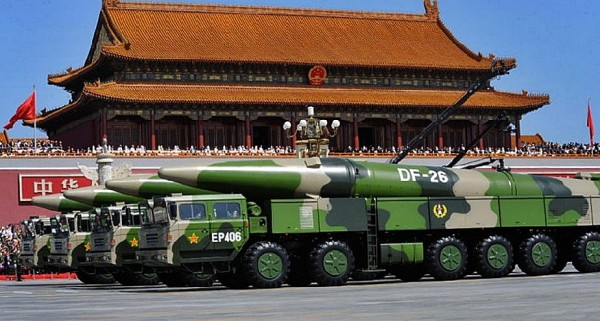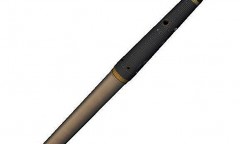By Arthur Dominic J. Villasanta , | May 11, 2017

DF-26 IRBMs on their TELs.
The launch by the People's Liberation Army Rocket Force (PLARF) of one of its DF-26 intermediate range ballistic missiles from a location facing the Bohai Sea apparently sent a less than frightening message to both South Korea and the United States to shut down a THAAD anti-missile battery that became operational last week.
Like Us on Facebook
The launch of a DF-26, which is also an anti-ship ballistic missile (ASBM) designed to destroy U.S. Navy warships, was loudly trumpeted in Chinese state-controlled media. Chinese military analysts said this rare high-profile announcement is China's blunt response to the deployment of the Terminal High Altitude Area Defense (THAAD) system in South Korea.
China's message: remove THAAD or China will remove the American missile system with a barrage of its own ballistic missiles.
What struck some western experts, however, was China's using a DF-26 to ram home this warning since this IRBM is precisely the type of missile THAAD is very good at shooting down.
As an analogy, using the DF-26 to intimidate THAAD is like using a cobra to frighten a mongoose. And mongoose are famed as efficient cobra killers.
DF-26 is an IRBM, as is North Korea's road-mobile Hwasong-10 (or Musudan) IRBM, which is one of the missiles THAAD was deployed to destroy. Many of the missiles launched by North Korea since 2016 were Hwasong-10s.
"Given the landing area (in the Bohai Sea), the test is obviously aimed at THAAD in South Korea," said military analyst Liang Guoliang.
China's Ministry of National Defense was deliberately vague in reply to questions about the missile and the missile launch. It said PLARF "recently conducted an operational test for its new-type missile weapons in waters of the Bohai Sea and achieved the expected results."
This test was meant "to improve the troops' capability of carrying out missions and efficiently deal with national security threats."
Some Chinese analysts argue the new-type missile weapons referred to by the ministry is the DF-26B (also called the DF-31) and not the older DF-26.
-
Use of Coronavirus Pandemic Drones Raises Privacy Concerns: Drones Spread Fear, Local Officials Say

-
Coronavirus Hampers The Delivery Of Lockheed Martin F-35 Stealth Fighters For 2020

-
Instagram Speeds Up Plans to Add Account Memorialization Feature Due to COVID-19 Deaths

-
NASA: Perseverance Plans to Bring 'Mars Rock' to Earth in 2031

-
600 Dead And 3,000 In The Hospital as Iranians Believed Drinking High-Concentrations of Alcohol Can Cure The Coronavirus

-
600 Dead And 3,000 In The Hospital as Iranians Believed Drinking High-Concentrations of Alcohol Can Cure The Coronavirus

-
COVID-19: Doctors, Nurses Use Virtual Reality to Learn New Skills in Treating Coronavirus Patients









